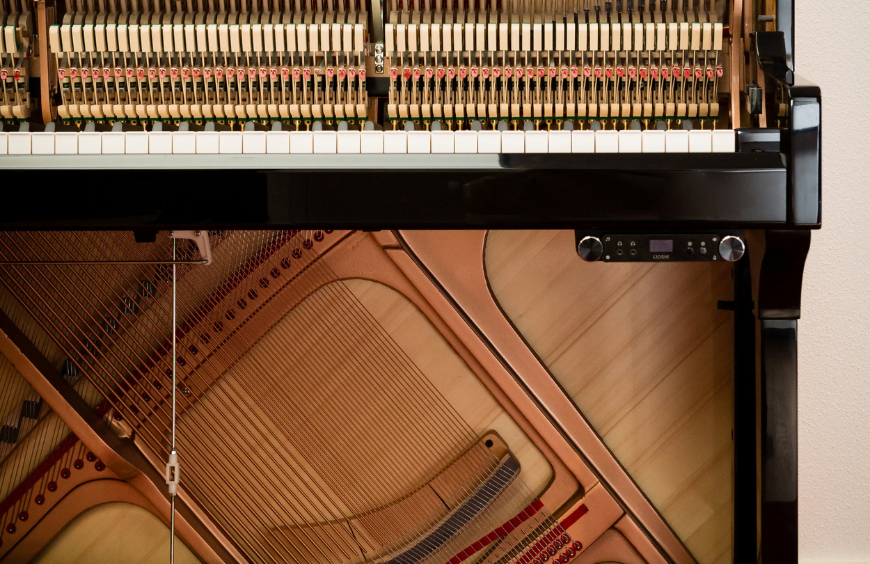No products in the cart.

A silent piano, also known as a hybrid or digital acoustic piano, is a type of acoustic piano that has the ability to be played silently. In silent mode, the piano’s hammers are prevented from striking the strings, allowing the player to use headphones for private practice. Instead of producing sound directly from the strings, sensors detect the movement of the piano keys, and this information is converted into MIDI (Musical Instrument Digital Interface) signals. These MIDI signals can be sent to an electronic sound module or a digital piano, which generates the sound that is then played through the headphones.
Silent pianos are a popular choice for pianists who want the experience of playing on an acoustic piano while also having the option of practicing silently. This allows for late-night or apartment practice without disturbing others. Additionally, silent pianos often offer additional features such as recording capabilities, built-in sound libraries, and connectivity options that expand the range of musical possibilities.

There are few pianos that comes with a silent system installed like KAWAI Anytime Piano. A silent piano is an acoustic piano with an added functionality of enabling private practice via headphones.Silent pianos are available in both grand and upright models
There are also few companies who manufacture an add-on silent system which can be added to most of the Acoustic pianos to convert them to digital without loosing the actual feel and touch.
This can be achieved by a bar moving into place to stop the hammer striking the string when the piano is switched to silent mode. Instead sensors convert the key movement to an electronic sound allowing the player to listen to the music they are creating through headphones.
What About The Sustain Pedal?
In a silent piano system, the sustain pedal functionality is typically preserved. When the piano is in silent mode, the sustain pedal still functions as it would on a traditional acoustic piano, even though the sound of the strings is muted. When you press the sustain pedal on a silent piano, the sensors detect the pedal movement, and the MIDI signals generated by the sensors include the information about the sustain pedal position. These MIDI signals are then sent to the sound module or digital piano, which applies the appropriate sustain effect to the generated sound.
This allows the pianist to use the sustain pedal to enhance their playing, even when practicing silently with headphones. The sustain pedal adds richness and depth to the sound produced by the electronic sound module or digital piano, simulating the effect of the sustain pedal on an acoustic piano. So, in summary, the sustain pedal functionality is typically included in a silent piano system, and it is designed to work seamlessly with the electronic sound module or digital piano to produce the desired sustain effect.

Does Retrofitting An Acoustic Piano With A Silent System Offer The Best Of Both Worlds For MIDI Enthusiasts?
Retrofitting an acoustic piano with a silent system can indeed offer the best of both worlds for MIDI enthusiasts. It combines the acoustic feel and touch of a traditional piano with the versatility and digital capabilities of MIDI technology. By retrofitting an acoustic piano with a silent system, you can enjoy the experience of playing on a high-quality acoustic instrument while also having the option to connect it to MIDI devices and explore a wide range of digital possibilities. This can be particularly appealing for musicians who want to integrate their piano playing with computer software, digital audio workstations (DAWs), or other MIDI-enabled instruments.
With a silent system, the sensors installed in the piano detect key movements and convert them into MIDI signals. These signals can then be sent to external MIDI devices such as synthesizers, sound modules, or software instruments. This allows you to use your acoustic piano as a MIDI controller, triggering a variety of sounds and effects in real-time.
Additionally, retrofitting a piano with a silent system often provides other benefits such as headphone practice, recording capabilities, and connectivity options. You can practice silently using headphones, record your performances digitally, and even connect your piano to computers or other audio equipment for further exploration and creativity.
However, it’s worth noting that retrofitting an acoustic piano with a silent system is an additional investment and involves modifications to the instrument. It’s essential to work with a reputable technician or piano specialist who can ensure that the installation is done properly and in a way that preserves the piano’s acoustic integrity. In summary, retrofitting an acoustic piano with a silent system can offer a compelling combination of acoustic and digital capabilities, providing MIDI enthusiasts with the best of both worlds.

How Much Does This System Cost?
The cost of a silent piano system can vary depending on several factors, including the brand, model, and additional features. Generally, the price range for a silent piano system can be anywhere from a few thousand dollars to tens of thousands of dollars.
The cost of retrofitting an existing acoustic piano with a silent system can be lower compared to purchasing a new silent piano outright. Retrofitting involves installing the necessary sensors, MIDI interface, and sound module into the existing piano.
On the other hand, if you’re considering purchasing a new silent piano, the cost will depend on the quality of the instrument itself, in addition to the silent system. High-end brands and models tend to have a higher price tag, reflecting their craftsmanship, materials, and overall performance.
It’s important to note that prices can vary significantly, so it’s a good idea to research different brands, models, and retailers to get an accurate idea of the cost.
Luckily there are quite a few silent system models out there, however, most dealers recommend you have a professional install it, as the process of retrofitting this system does indeed quite complicated and take minimum half day to have it up and running..

